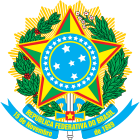| This article is part of a series on the |
 |
|---|
The Federal territories of Brazil (Portuguese: Territórios federais do Brasil) are sub-national administrative divisions overseen by the federal government of Brazil. Unlike the federative units of Brazil, federal territories are directly administered by the federal government. The 1988 Constitution of Brazil was the final constitution to regulate the establishment and disestablishment of federal territories. Federal territories can be created from federative units after a successful plebiscite involving the residents who would belong to the new territory. They can either be dissolved by elevation to new states or reintegration into the federative units that they were dismembered from.[1]
If a new territory is created, it can have municipalities and will elect four federal deputies. Unlike federal units, the territories have no senators because they are directly managed by the federal government. If a federal territory has more than 100 thousand residents, it will have a governor elected directly by the president and central judiciary, first and second level courts, and representative members of the Public Prosecutor's Office and Public Defender's Office.
Brazil does not currently have any federal territories. The 1988 Constitution abolished all three territories then existing: Fernando de Noronha became a state district of the state of Pernambuco, and the Federal Territory of Amapá and the Federal Territory of Roraima were elevated to statehood.[2]
- ^ Cite error: The named reference
:4was invoked but never defined (see the help page). - ^ Porto, Jadson Luís Rebelo (March 1999). "Os territórios federais e a sua evolução no Brasil" [The federal territories and their evolution in Brazil] (PDF). Revista de Educação, Cultura e meio ambiente (in Brazilian Portuguese). III (15).